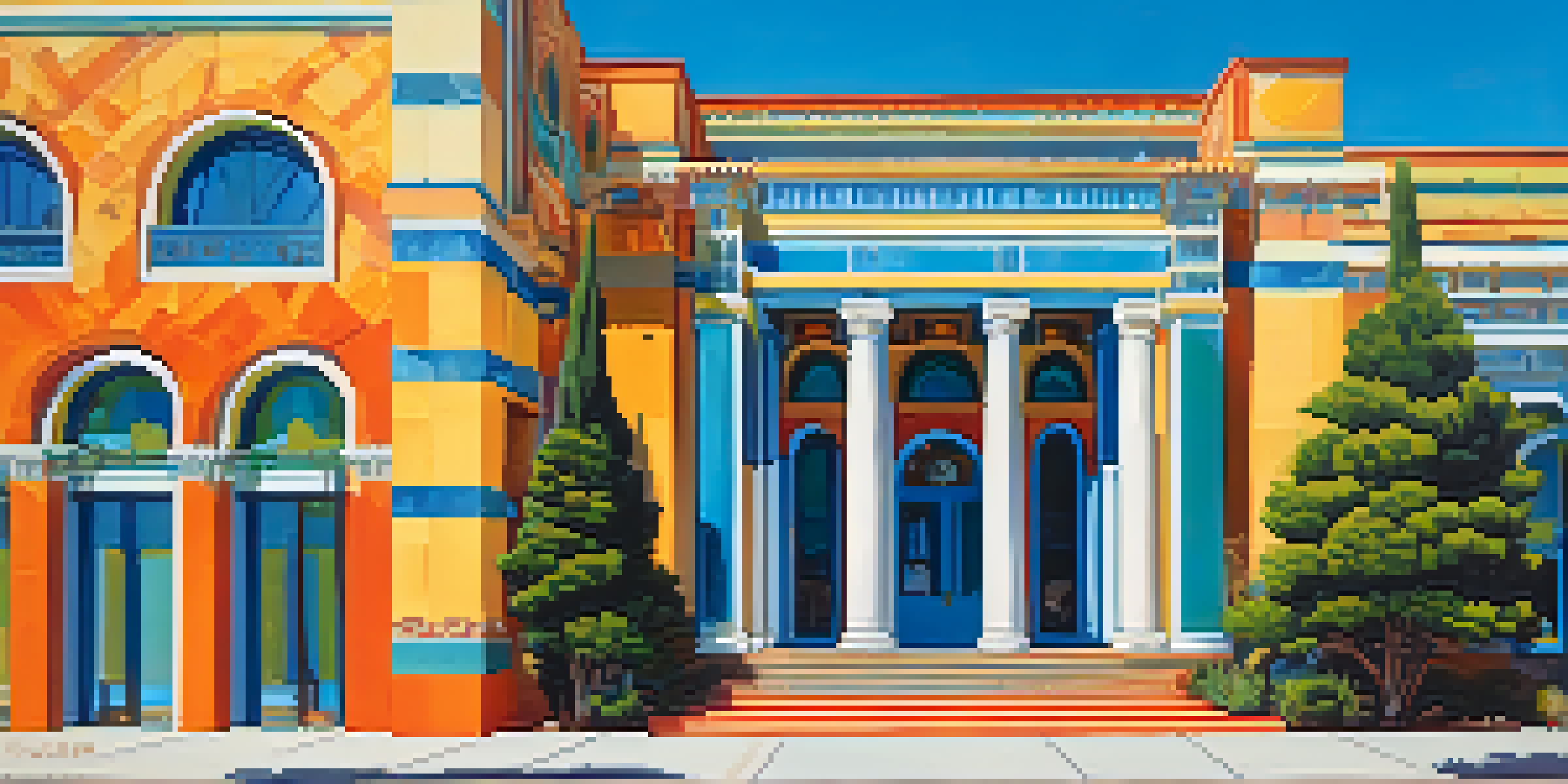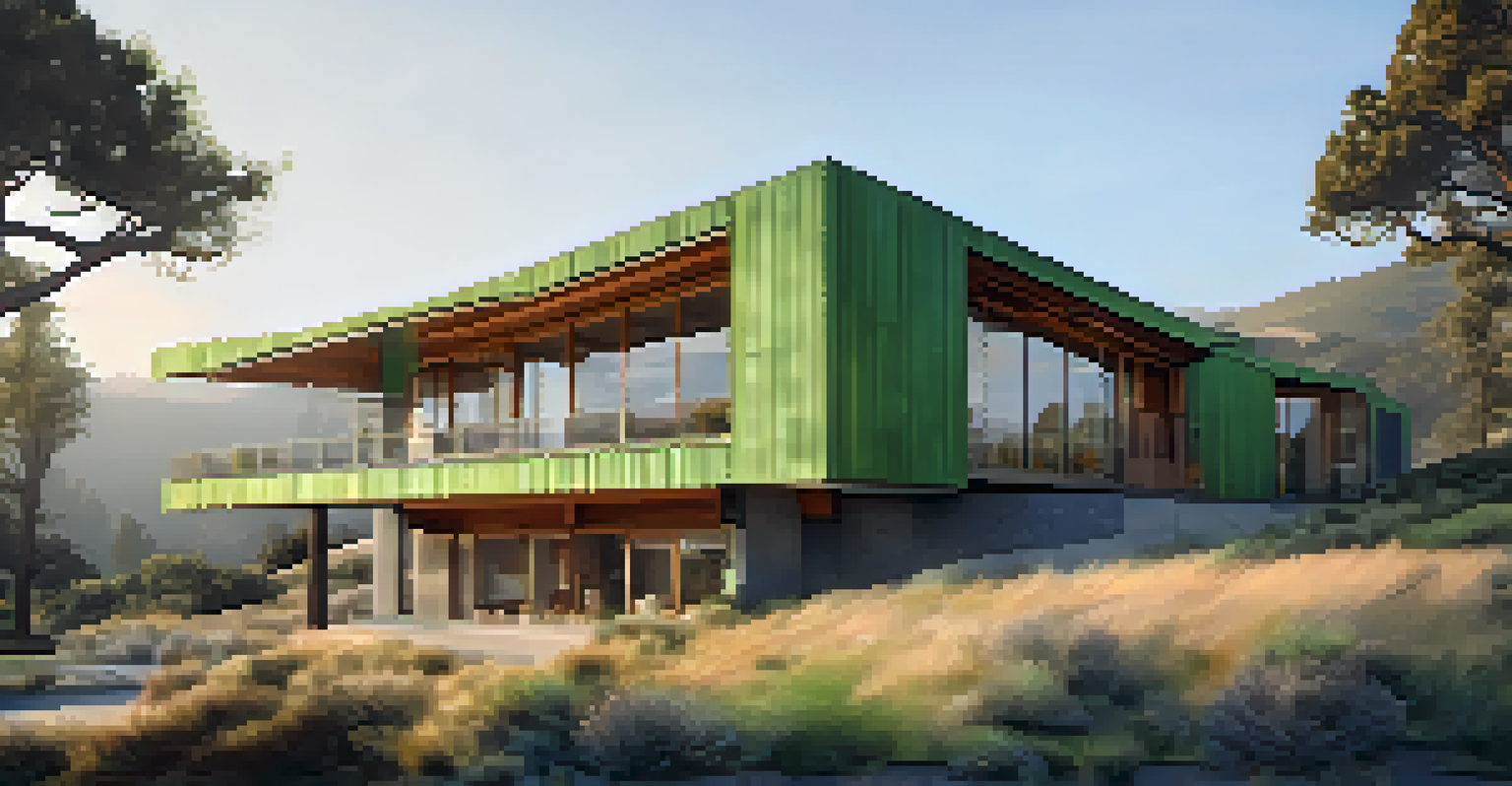Key Features of California's Postmodern Architectural Movement

Introduction to California's Postmodern Architecture
California's postmodern architectural movement emerged in the late 20th century, marking a departure from the modernist principles that dominated before it. This shift was characterized by a playful embrace of diversity in design, materials, and historical references. Architects sought to create structures that felt more human, relatable, and culturally resonant, often reflecting the eclectic nature of California itself.
Architecture should speak of its time and place, but yearn for timelessness.
Postmodern architecture is often recognized for its bold colors, intricate details, and unexpected forms. Rather than strictly adhering to minimalist ideals, postmodern buildings frequently incorporate elements from various styles, creating a rich tapestry of visual experiences. This approach allows for a unique storytelling aspect, where each structure can convey cultural narratives and personal histories.
Key figures in this movement, such as Frank Gehry and Michael Graves, pioneered innovative designs that challenged conventional architectural norms. Their work not only transformed skylines but also encouraged a broader acceptance of creativity in urban landscapes. As we delve into the key features of this movement, it becomes evident how California's cultural landscape has profoundly influenced its architectural identity.
Embracing Eclecticism in Design
One of the most striking features of California's postmodern architecture is its embrace of eclecticism. This style draws inspiration from various historical periods, cultures, and design philosophies, resulting in vibrant and diverse structures. For instance, a single building might mix classical columns with vibrant tile work, reflecting the state's rich multicultural heritage.

This tendency to blend styles is not merely aesthetic; it also serves a practical purpose. By incorporating familiar elements from different eras and cultures, architects create spaces that resonate with a wide audience. This approach invites inhabitants to connect with their environment on a more personal level, fostering a sense of belonging and community.
Eclecticism Defines Postmodern Design
California's postmodern architecture embraces a blend of styles from various cultures and historical periods, creating vibrant and relatable structures.
Eclecticism in design also challenges the notion of 'pure' architectural styles. Instead of adhering to strict guidelines, architects can play with their creative freedom, leading to innovative and unexpected outcomes. This adventurous spirit is emblematic of California's broader ethos, where experimentation and individuality are celebrated.
Playfulness and Humor in Architecture
Postmodern architecture in California is often infused with playfulness and humor, a refreshing departure from the seriousness of modernism. This can manifest in whimsical shapes, bright colors, and unexpected details that surprise and delight observers. For example, the iconic Portland Building, designed by Michael Graves, features a colorful facade and exaggerated classical elements that invite a smile.
The best buildings are those that are alive, that people can participate with and react to.
Such playful designs serve a dual purpose: they capture attention and encourage interaction. Buildings become not just functional spaces but also landmarks that spark curiosity and conversation. This lighthearted approach reflects California's laid-back lifestyle and creative spirit, making architecture an integral part of the social fabric.
Moreover, this emphasis on whimsy can be seen as a response to the rapid urbanization and technological advancements of the era. In a world increasingly dominated by seriousness and efficiency, architects sought to inject joy and personality into the built environment, reminding us that spaces can be both practical and enjoyable.
Incorporation of Historical References
Another hallmark of California's postmodern architecture is the intentional incorporation of historical references. Architects often draw from a variety of architectural styles, creating a dialogue between the past and present. This technique not only pays homage to history but also allows for a reinterpretation that feels relevant in a contemporary context.
For instance, the use of Roman arches or Art Deco motifs in modern buildings creates a sense of continuity, linking modern life with historical narratives. This blending of styles can evoke feelings of nostalgia while simultaneously embracing the future. Such references can also serve as cultural markers that celebrate California’s diverse heritage.
Playfulness Characterizes Architecture
Infused with humor and whimsy, California's postmodern buildings invite curiosity and interaction, reflecting the state's creative spirit.
By incorporating these historical elements, architects enrich the architectural landscape and provide layers of meaning to their work. This approach invites viewers to engage with the building on multiple levels, sparking curiosity about the stories and traditions that have shaped its design. It’s a testament to the idea that architecture is not just about structures but also about the narratives they convey.
Bold Colors and Textures
California's postmodern architecture is renowned for its bold use of colors and textures, breaking away from the muted palettes of modernism. Bright, vibrant hues are often employed to create striking contrasts and evoke emotional responses. This lively color scheme not only enhances the visual appeal of buildings but also reflects the vibrant culture and diverse lifestyles found throughout the state.
Textures play a crucial role as well, with materials like stucco, concrete, and glass being utilized in innovative ways. These varied textures add depth and interest to facades, making them visually engaging from multiple angles. The interplay between different materials can create dynamic surfaces that change appearance depending on the time of day and the viewer's perspective.
This focus on color and texture not only enlivens the urban environment but also encourages a sense of playfulness. Buildings become lively canvases that invite exploration and interaction, reinforcing the idea that architecture can be both functional and artistically expressive. In this way, California's postmodern structures often act as a reflection of the state's colorful identity.
Sustainability in Postmodern Architecture
As environmental awareness has grown, California's postmodern architects have increasingly incorporated sustainable practices into their designs. This movement towards sustainability reflects a broader cultural shift towards eco-consciousness and responsible living. By integrating green technologies and sustainable materials, architects are creating buildings that not only look good but also minimize their environmental impact.
Innovative designs often feature energy-efficient systems, green roofs, and reclaimed materials, demonstrating a commitment to sustainability without compromising aesthetic appeal. For example, the California Academy of Sciences in San Francisco showcases a stunning green roof that blends seamlessly with its surrounding landscape, embodying the principles of both postmodern design and ecological responsibility.
Sustainability Shapes Future Designs
The integration of sustainable practices in California's postmodern architecture highlights a commitment to eco-consciousness without sacrificing aesthetic appeal.
This intersection of sustainability and postmodernism highlights a forward-thinking approach to architecture, where beauty and functionality can coexist with environmental stewardship. As more architects embrace these principles, California continues to lead the way in demonstrating how architecture can positively impact both society and the planet.
Conclusion: The Legacy of California's Postmodern Architecture
California's postmodern architectural movement has left an indelible mark on the landscape, characterized by its eclectic designs, playful elements, and incorporation of historical references. As we explore the key features of this movement, it's clear that these buildings are not just structures; they are expressions of culture, creativity, and community. They invite us to engage with our surroundings and to appreciate the stories embedded within the architecture.
The legacy of postmodern architecture in California continues to inspire architects and designers around the world. Its boldness and willingness to break conventions encourage new generations to rethink their approach to design. As we look to the future, the principles of this movement will likely inform the ongoing evolution of architecture in an increasingly diverse and complex world.

Ultimately, California's postmodern architecture serves as a reminder of the power of creativity in reshaping our environments. It demonstrates that architecture can be a living art form, capable of reflecting the multifaceted nature of human experience while fostering a sense of connection among communities.